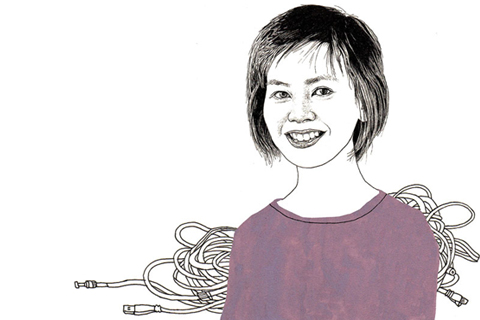Technology companies such as Google, Facebook and Amazon are investing millions of dollars in data centres to power their vast computing enterprises. These sprawling complexes contain thousands of servers that allow the public to exchange pictures, emails, videos and more online. Trouble is, the wires that run inside these servers and between them aren’t always ideal for communicating huge amounts of data in a fast and energy-efficient way.
Joyce Poon, a professor of electrical and computer engineering, is working on a potential solution. Light is much more efficient than conventional copper wiring for transmitting data over large distances, such as between cities or continents. But so far, creating the devices that use light to relay data over short distances, such as within a data centre or an individual computer, has been difficult. This is because the fibre optic cables and components used to transmit light are costly and difficult to manufacture at a small scale.
The challenge, says Poon, 32, is to come up with photonic devices – made from electronic and new types of materials – that can be scaled down to the incredibly small dimensions of modern micro-electronic components. She is collaborating with academic and commercial partners in Canada, the U.S., Asia and Europe, and, in a recent experiment with IBM Research, demonstrated a compact, energy-efficient optical switch that worked twice as fast as what was conventionally thought to be the limit. Eventually the switch could operate as much as 100 times faster, says Poon, recently named by MIT’s Technology Review as one of the world’s top 35 innovators under 35.
Poon notes that aside from the ongoing technical challenges and the physical limits of the materials, there are also practical obstacles to overcome before any new devices make it to market. She and her team must find a way to manufacture them so they work with an array of existing electronics equipment and are cost-effective. Both elements are crucial.
As more and more everyday things – such as cars, roads, even refrigerators – are embedded with computer chips, the amount of data that needs to be processed, communicated and stored (and the electricity required to do this) will continue to grow at an exponential rate. At some point in the not-distant future, our computer networks will buckle under the ever-growing torrent of data – unless current limits of speed and energy-efficiency are surpassed. Poon is working to achieve a breakthrough, and is excited about the possibilities that even faster communication and more powerful computing will open up – particularly in such complex fields as cosmology, climate change and proteomics. “If this all comes together, I think we can solve some really big problems in science – and our society,” she says.
Joyce Poon explains her research into photonic devices to make computers faster.
Recent Posts
U of T’s Feminist Sports Club Is Here to Bend the Rules
The group invites non-athletes to try their hand at games like dodgeball and basketball in a fun – and distinctly supportive – atmosphere
From Mental Health Studies to Michelin Guide
U of T Scarborough alum Ambica Jain’s unexpected path to restaurant success
A Blueprint for Global Prosperity
Researchers across U of T are banding together to help the United Nations meet its 17 sustainable development goals






